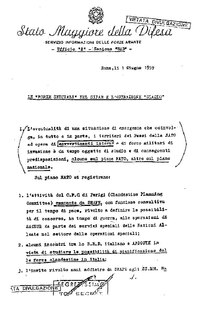
Back غلاديو Arabic Qladio əməliyyatı Azerbaijani Операция Гладио Bulgarian Operació Gladio Catalan Gladio Czech Operation Gladio Danish Gladio German Επιχείρηση Γκλάντιο Greek Gladio Esperanto Operación Gladio Spanish
| Operation Gladio | |
|---|---|
| Secret stay-behind network Part of the Cold War | |
 Italian Military Secret Service (SIFAR) report on Operation Gladio, 1959 | |
| Operational scope | Covert operations |
| Location | |
| Planned | 1952–1990 |
| Planned by | Western intelligence agencies |
| Objective | Counter an invasion of Europe by the Warsaw Pact (claimed by US Government) |
| Date | 1 January 1952 |
| Executed by |
|
| Outcome | Continued operations into the 1990s, exposure and disclosure |
Operation Gladio was the codename for clandestine "stay-behind" operations of armed resistance that were organized by the Western Union (WU) (founded in 1948), and subsequently by NATO (formed in 1949) and by the CIA (established in 1947),[1][2] in collaboration with several European intelligence agencies during the Cold War.[3] Although Gladio specifically refers to the Italian branch of the NATO stay-behind organizations, Operation Gladio is used as an informal name for all of them. Stay-behind operations were prepared in many NATO member countries, and in some neutral countries.[4]
According to several Western European researchers, the operation involved the use of assassination, psychological warfare, and false flag operations to delegitimize left-wing parties in Western European countries, and even went so far as to support anti-communist militias and right-wing terrorism as they tortured communists and assassinated them, such as Eduardo Mondlane in 1969.[5][6][7][8] The United States Department of State rejected the view that they supported terrorists and maintains that the operation served only to resist a potential invasion of Western European countries by the Soviet Union.[9]
- ^ Pedrick, Clare (14 November 1990). "CIA Organized Secret Army in Western Europe". The Washington Post. ISSN 0190-8286. Archived from the original on 24 March 2023. Retrieved 14 January 2021.
- ^ Agee, Philip; Wolf, Louis (1978). Dirty Work: The CIA in Western Europe.
- ^ Ganser, Daniele (2004). NATO's Secret Armies: Operation GLADIO and Terrorism in Western Europe.
- ^ Haberman, Clyde; Times, Special to The New York (16 November 1990). "Evolution in Europe; Italy Discloses Its Web Of Cold War Guerrillas". The New York Times. Archived from the original on 18 March 2023. Retrieved 20 February 2015.
- ^ Del Pero, Mario (2001). "The United States and "Psychological Warfare" in Italy, 1948–1955". The Journal of American History. 87 (4): 1304–1334. doi:10.2307/2674730. ISSN 0021-8723. JSTOR 2674730. PMID 17152679. Archived from the original on 17 January 2023. Retrieved 14 January 2021.
- ^ Ganser, Daniele (1 October 2006). "The CIA in Western Europe and the abuse of human rights". Intelligence and National Security. 21 (5): 760–781. doi:10.1080/02684520600957712. ISSN 0268-4527. S2CID 154898281. Archived from the original on 14 January 2023. Retrieved 14 January 2021.
- ^ Williams, Paul L. (2015). Operation Gladio: The Unholy Alliance Between the Vatican, the CIA, and the Mafia.
- ^ Chronology Archived 2008-12-12 at the Wayback Machine, Secret Warfare: Operation Gladio and NATO's Stay-Behind Armies, ETH Zurich
- ^ "Misinformation about 'Gladio/Stay Behind' Networks Resurfaces". USINFO. U.S. Department of State's Bureau of International Information Programs. 20 January 2006. Archived from the original on 28 March 2008. Retrieved 17 August 2023.
During the Cold War, West European countries set up clandestine 'stay behind' networks, which were designed to form the nucleus of resistance movements if the Soviet Union invaded and occupied Western Europe. ... A thirty year-old Soviet forgery has been cited as one of the central pieces of 'evidence' for the false notion that West European 'stay-behind' networks engaged in terrorism, allegedly at U.S. instigation. This is not true ... .